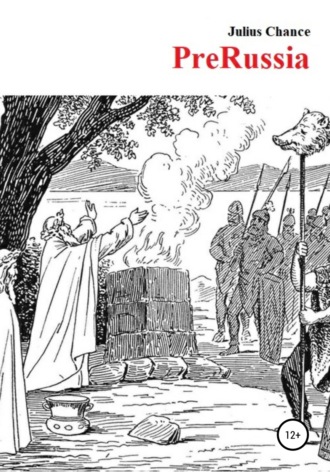
Julius Chance
PreRussia
So, what is the age of Russia?
According to Lomonosov – no less than that of Ancient Greece and Rome. Many researchers agree with his assessment. Some of them rely on the "Letter of Alexander the Great to the Slavs" 38, which reads as follows: "We, Alexander, are the son of the supreme god Jupiter in heaven and Philip, King of Macedon on earth, the ruler of the world from sunrise to sunset and from noon to midnight, the conqueror of the Median and Persian kingdoms, Greek, Syriac and Babylonian , etc . To the enlightened Slavic genus and its language. Mercy, peace, respect and greetings from us and our successors in the governance of the world after us. Since you have always been with us in loyalty in battle, reliable, brave and restless, we grant and freely give you forever all the lands from the full sea of the great Arctic Ocean to the Italian southern rocky Sea, so that no one dares to settle in these lands but only your kind and if any outsiders have been discovered here, they will become your serf or servant with their offspring forever. Given in the city of Alexandria, founded by us on the glorious river Nile in the 12th year of our reign with the permission of the great gods Mars, Jupiter and the goddess Minerva. The witnesses of this are the noble Altera, our treasurer, and the other 11 princes, whom, in the event of our death without sons, we leave our and the whole world’s heirs."
This is a very interesting and at the same time devilishly insidious document, first mentioned by the Czech historian Vaclav Gaik in the "Czech Chronicle" of the Brno Archive describing the events of 1348. In 1516 the Czech historian Joseph Pervolf of the University of Warsaw discovered a copy of this letter in Latin. In 1551 this document was printed in Polish, in 1596 – in German, in 1601 – in Italian. He becomes widely known in Europe and soon in Russia. It was believed that the original was kept in the archive of the Czech Kingdom.
For five hundred years there have been heated debates and disputes among scientists about the authenticity of this document. Naturally, German-speaking scientists actively dispute the authenticity of the Letter because it gives priority to the Slavs and the Slavic language in Europe. And this was at a time when Ancient Rome, the cradle of Western civilization, was just beginning to gain its strength. Photos of the original text of the diploma are easily found on the Internet. We do not give it here as they are protected by copyright.
There are some indirect evidences that the document may be authentic. The Charter mentions the twelfth year of Alexander's reign. This date falls on 324 BC, the penultimate year of his life. A campaign to distant India has just ended. Although it turned out to be not very successful, almost all the states of the Ancient World lay at the feet of the Great commander. It is known that after the Indian campaign Alexander the Great was actively preparing for a campaign to conquer "wild, barbaric" Europe. Now Europe and North America are the centers of world civilization, but in that distant past Greece and Rome (to a lesser extent) were such centers while the rest of Europe was considered wild and barbaric.
Alexander's favorite technique was "divide and conquer" playing on contradictions in the camp of the alleged enemy. This slogan is as old as the world. It was widely used by many leaders, leaders, princes, tsars before Alexander and it is now. During the conquest of the Persian Empire Alexander skillfully opposed the population of provinces to the Persians. As a result he was greeted with flowers as a liberator almost everywhere. Cities opened their gates wide before him without a fight. After the conquest of Egypt he was proclaimed the vicar of the God on earth and in some places even the God. He skillfully timed the trip to India to coincide with the internecine war between the Ruler of India and the Ruler of the Indian city of Taxila. Only fatigue and the murmur of his soldiers forced Alexander to turn back.
In preparation for the conquest of the "barbaric West", Alexander was likewise looking for allies in Europe and found the Slavs to be them. In those distant times they lived on the territory of modern Greece, Macedonia, Bulgaria, Romania, Hungary, Yugoslavia and Austria. Descendants of the defenders of Troy glorified by Homer, they took a lively part in Alexander's victorious campaigns. In addition, the land road from Greece to Europe ran through their lands. The ancient authors who wrote about the Slavs emphasized their love of freedom and bravery in battle.
No better allies could be found. The Macedonian letter to the Slavs is a poisoned knife stuck in the back of Europe by the iron hand of the Great commander. With one stroke of his pen he split the unity of Europe for millennia, spilled rivers of blood, opposing one European nation to another. Now we can only guess where the whole course of history would have turned and what would have happened to Europe if Alexander Macedonian had not died suddenly on the eve of the already prepared campaign. Scientists are still arguing about the authenticity of this letter.
There is a hypothesis that in addition to the letter to all Slavs, Alexander the Great also sent a separate letter specifically to the Russians when passing through the Czech land. The copies of that letter also spread to the Slavic countries. Alexander granted the Muscovite ancestors lands not from Aquilon to Italy but from the Baltic Sea to the Caspian.39
The Russian empress Catherine the Great (Catherine II, German by origin) knew about the existence of such a letter and considered it a genuine historical document.40 In her "Notes on Russian History" she wrote "16. They say that the Russ helped Philip of Macedon in the war three hundred and ten years before the Birth of Christ, his son Alexander as well and for bravery in this they got a charter written in golden words, which seems to be in the archives of the Sultan of Turkey. But since the sultan's baths are heated with archival papers, it is likely that this letter has also been used for that purpose long time ago, if it was there." 41 The opinions of historians are divided about the authenticity of this letter of Alexander the Great.
Russian Troy?
Back in the middle of the 19th century historian E.I. Klassen insisted that Slavic tribes existed even before the time of the city of Troy.42 Lomonosov M.V. in his "Ancient Russian History" also emphasizes that "the greatness and power of the Slavic tribe began many centuries before the ruin of Troy."
I, the humble author of this article, watched the film “Troy” in English in remote Australia in 2004. At that time I had not yet gone into the specific details of the history of Russia. After a few minutes of watching the movie I suddenly felt some inexplicable kinship with the Trojans. There was something in their faces, manners, clothes, actions that made them not strangers to me. Even the very name of Troy seemed painfully familiar to me as if I had known it since birth. Then I had a "wild and impossible" thought that the Trojans were Russians. Now the scientists are beginning to prove that my feelings had some basis – Troy was inhabited by Slavs indeed. Probably the creators of the film so scrupulously embodied the images of Troy and the Trojans based on legends, myths and excavation data that I saw the Trojans as kindred people.
Troy (also known as Ilion) was located in Asia Minor near the Dardanelles and controlled the sea trade routes of Europe and Asia. Such a beneficial strategic location allowed the Trojans to control all the trade flows of the Mediterranean and Black Seas, made them rich and strong. It caused envy among the Achaean Greeks and some peoples of the Black Sea region. According to a legend the Trojans blocked the narrow strait with a tension chain, not letting merchant ships through until they paid the established fee. There are certain reasons to believe that Troy did not exist on its own but was rather a part of the state "Mediterranean Russia".43
Seven cultural layers have been discovered at the excavation site of Troy. They are associated with different periods in the existence of historical Troy. There used to be several “Troys” in fact. The city itself turned out to be much older than the Homeric Troy – it was originally built in the 4th millennium BC by the Pelasgians, the ancestors of the Slavs. “It is known from history” – wrote E.I. Klassen – that the Trojans were called first Pelasgians, then Thracians, then Teucrians, after that Dardanians and finally Trojans, and their descendants after the fall of Troy – Pergamians and Kemeians.
He also notes that the Greeks called all of the Trojans, Macedonians and Phrygians to be Thracians, that the Thracians are descended from the Pelasgians. Among the Thracians as well as among the Pelasgians we meet many purely Slavic tribal names including the Russ and the Ruthenians, according to Herodotus. The Thracians wore forelocks as later the Little Russians (Malorossians) did; their graves were made in a mound, which is common among all the Slavs, their weapons were Slavic too. The most famous Thracian is Spartacus. After his capture by the Romans he almost demolished the Rome state by raising a slave rebellion. And since the Thracians were Slavs then the Trojans were too (as a part of the Thracians). The excavations found the majority of the buried Thracian girls with the specifically Slavic headdresses (kokoshniks).
Many sources call all the tribes of the Slavs with a common word – Wends. The chronicle of Fredegard, the 7th century A.C. says "… the Slavs, called Wends …". Ion of Bobby (also the 7th century A.C.) in his description of the life of St. Columbia says – “The idea came to him to go to the Wends who are also called the Slavs.” The Anglo-Saxon writer Alcuin of the times of Charlemagne wrote "We call the Slavs Wends." The Germans used to call all Slavs “Vend”. The Finns and the Estonians still call the Russians "Vene". And the Finnish name of Lake Ladoga is Veneimiere, which means “the Sea of Vene”.
The Fall of Troy
The main neighbor of Troy was the state of Paphlagonia inhabited by the Wends and located on the southern coast of the Black Sea, east of Troy. When the Greeks and their allies went to war against Troy, a detachment of the Wends of Paphlagonia came to its aid. And most of the other neighboring principalities of the Wends joined the defenders of Troy. At the end of the second song of the “Iliad” Homer gives a "Catalogue of ships" with the troops that arrived to help Troy. It lists the peoples who participated in Troy’s defense. Those are the Trojans (apparently from the towns around, not from Troy itself), the Wends, the Pelasgians, the Dardani, the Kikons, the Peons, the Thracians, the Phrygians, the Carians, the Lycians, the Medes and others. Most of these tribes (if not all) are Slavic. We may say that an ancient world war took a place there then.
It needs be noted that several Slavic tribes of the Black Sea region opposed Troy on the side of Greece. For instance, a detachment of Myrmidons led by Prince Achilles. This "ancient Greek" hero deserves a closer look. Achilles was the son of Peleus and the grandson of the Aegin ruler Aeacus. He was a noble Scythian from the city of Myrmikion near the Meotida Lake (the Sea of Azov). Exiled for his wild, cruel and insolent behavior, he settled in Thessaly (according to Leo the Deacon, a Byzantine historian of the 10th century).
The cut of Achilles’ cape fastened with a clasp, the habit of fighting on foot, blond hair, light blue eyes are typical of the ancient Slavs. Leo Deacon, like all medieval authors, considered the Scythians to be not the Scythian nomads (Iranians) but the entire population of the southern Russian steppes (Achilles is not nomadic at all, indeed). Many medieval authors (for instance Eustace of Thessaloniki and Attaliot) considered Achilles to be a Tauro-Scythian and even a Russian.44 Leo Deacon refers to the Jewish prophet Ezekiel who emphasizes the connection of Achilles with the Russ people.
The abduction of Helen the Beautiful, the wife of King Menelaus of Sparta by Paris was not a reason, but just a pretext for war. The war was cruel and merciless. The siege of Troy lasted for 10 years.
After the fall of Troy the Wends left their land mainly in three ways – some went to the Armenian (then Iranian) highlands around the Lake Van where the state of Urartu was subsequently formed. The kings there had names Rusa-I and Rusa-II which is no coincidence – the Armenians have always firmly held on to Russia. Another group of Wends traveled by sea and reached the northwestern coast of the Adriatic Sea (subsequently the city of Venice arose there).
After a certain period of time the Wends were scattered throughout Europe. They settled not only along the coast of the Adriatic Sea but to the north as well. They settled on the Danube, Dniester, Dnieper and Vistula, reached the Baltic Sea, Scandinavia, France, Ireland and Britain. The famous "Troyanian path" is the path along which the ancient Russians returned to their ancestral home, to the North. Professor Abrashkin A.A. writes about this in great detail.45






